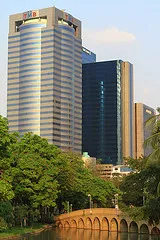
Stable outlook for TMB despite high non-performing loans: Moody’s
However, the bank’s profitability remains weak compared to other similar-sized Thai banks.
Moody's Investors Service has affirmed the following ratings of TMB Bank Public Company Limited: standalone D- bank financial strength rating, which maps to Ba3 on the long-term scale; and Baa3/Prime-3 long-term foreign currency deposit.
All ratings have a stable outlook.
Moody's affirmation of TMB's ratings is based on the bank's audited financial statements for 2010 and 1H 2011, as prepared under local GAAP.
Here’s more from Moody’s:
| RATINGS RATIONALE While TMB's financial condition has stabilized, its ratings remain constrained by (i) low profitability metrics when compared to its global and local peers; (ii) the burden of still high albeit legacynon-performing loans; and (iii) very high single-borrower concentrations and weak efficiency ratios, again when compared to its peers. In recent years, TMB has been through a restructuring process that has led to reductions in its loan book. While this has helped stabilize the bank after a difficult period, its profitability remains weak compared to other similar-sized Thai banks and its "D-" rated peers. Pre-provision profits were only 1% of average risk-weighted assets for 2010. In addition, the bank's loan portfolio has a very high degree of single-borrower concentration, relative to core capital and earnings. This is higher than both its local and global peers. Such concentration exposes earnings to volatility, and may affect asset quality in a downturn. Its top 20 loan exposures is over 700% of pre-provision profits. On the other hand, Moody's observes that the ratings are underpinned by (i) the size of its franchise as the seventh-largest in Thailand, with a 5% share of loans, and 6% of assets and deposits; (ii) the bank's stable funding and liquidity profile; and (iii) its improving fundamentals after investing three years in risk management, re-organisation, and branch transformation. On another positive note, TMB's asset quality has continued to improve over recent years, though it is still weak when compared to global peers. Non-performing loans (NPLs, defined as loans 90+ days overdue) declined to Bt32.6 billion (8.6% of gross loans) at end-June 2011 from Bt 54.1 billion (14.7%) at end-2009, due to active debt management, NPL sales and minimal formation of new NPLs. Its loan-loss reserve coverage ratio, though still low, increased to 64% of gross loans at 1H 2011 from 54% at end-2010. TMB's loan-to-deposit ratio is modest, as evidenced by an 84% loan-to-deposit ratio at the end of 1H2011 (88% at end-2010). Its stable core deposit base accounted for nearly 83% of its funding at end- 2010, with a profile mainly in local currency. TMB's Tier I capital ratio stood at 11.6% at the end of 1H 2011. But, in stressed conditions, the bank's solvency is less resilient than higher rated peers due to its relatively weaker earnings and loan loss reserves cushion. An upgrade of its stand-alone rating would require that its financial performance in the next 18 months continues to improve, such that (i) its NPL ratio declines below 4%; (ii) its Tier I ratio remains above 10%; (iii) its single-borrower concentration is significantly diluted; and/or (iii) its cost-to-income ratio falls below 50%. On the other hand, the stable outlook on the ratings could change to negative if (i) the difficult operating environment in Thailand worsens, and TMB's asset quality deteriorates such that its new annual NPL formation rate reaches 1.5% of gross loans and/or its annual credit costs reaches 0.75% of gross loans; (ii) the loan-to-deposit ratio rises above 100%; and/or (iii) the bank's capital adequacy declines significantly, such that its Tier I ratio falls below 8%. |













 Advertise
Advertise










